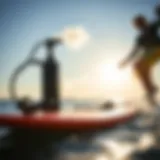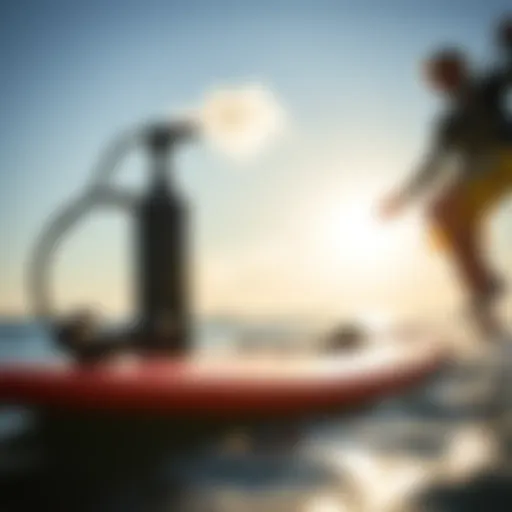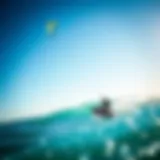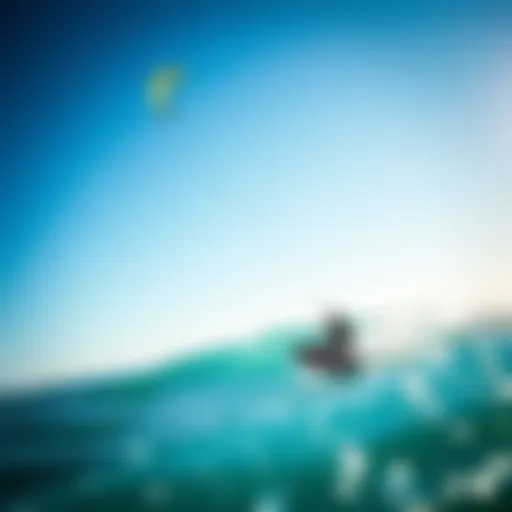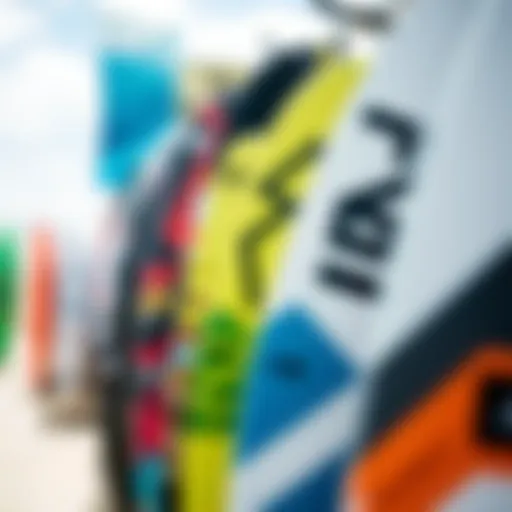Comprehensive Guide to Jekyll Island Weather for Kiteboarding


Intro
Jekyll Island, Georgia, is not just another pretty beach destination; it’s a kiteboarder’s playground. Year-round, both novice and seasoned kiteboarders flock to its sandy shores, driven by the allure of the winds and waters. But before you strap on that harness and hit the waves, it's crucial to understand what Mother Nature has in store. The island's weather patterns are anything but predictable, and knowing how to navigate these can mean the difference between an exhilarating adventure and a frustrating day on the water.
The climatic conditions influence everything from wind strength to sea temperatures. This guide aims to explore those essential aspects to help you prepare for your kiteboarding journey on Jekyll Island. After diving into seasonal variations, wind patterns, and tips on harnessing the island's unique weather, you’ll be equipped with knowledge that is crucial for making your outings both enjoyable and safe.
Embarking on this exploration, we’ll delve into the specifics of the weather, so whether you are planning a weekend getaway or a lengthy sabbatical devoted to the sport, you’re bound to find actionable insights and tips to elevate your kiteboarding game.
Gear Insights
Latest Gear Reviews
Keeping up with the tides means keeping up with the gear. The kiteboarding equipment market fizzes with innovations aiming to enhance performance and safety. Recent standout products include the Duotone Evo, praised for its versatility and user-friendly design, making it a favorite among both newbies and pros. For those wanting to ride with a bit more edge, the Naish Pivot offers that sought-after performance in gusty winds, pushing even the most skilled riders to new heights.
Don’t forget about safety equipment! The Ion radium harness has caught the eye of many for its comfort and support, which is crucial when battling those Wavy conditions.
Essential Gear for Beginners
If you’re just starting out, navigating the gear landscape may feel overwhelming. Keep it simple: you’ll need a reliable kite, a sturdy board, and a good harness. Here’s a quick breakdown for the budding kiteboarder:
- Kite: Beginner models like the Cabrinha Switchblade are known for their stability and ease of use.
- Board: A larger board, such as the Slingshot Misfit, provides a stable platform for learning.
- Harness: Look for a comfortable waist harness; the Mystic Majestic is often recommended.
Getting the right gear sets the foundation for your kiteboarding experience. As you gain confidence, you can explore more specialized equipment.
Techniques and Tips
Advanced Tricks and Techniques
For those who have moved beyond the basics, Jekyll Island’s diverse conditions present the perfect opportunity to hone your skills. Mastering jumps and spins in different wind conditions can be exhilarating. Learning tricks like the backroll or early jumping will surely elevate your game.
Engaging with local kiteboarding communities, like those on reddit, can provide insights into new techniques and destination tips.
Safety Practices for Kiteboarders
While fun is the name of the game, it’s imperative to prioritize safety. Before heading out:
- Check the Weather: Wind conditions can change rapidly; always keep an eye on the forecast.
- Know Your Limits: Don’t push too far beyond your skill level; set realistic goals for each session.
- Kite Responsibly: Always respect the space of fellow riders and be aware of your environment.
"Safety first, fun second! Kiteboarding is all about enjoying the ride, so be smart about it."
Informed decisions will enhance not just your skills but also your overall enjoyment of kiteboarding. The combination of appropriate gear, advanced techniques, and solid safety practices can pave the way for incredible kiteboarding adventures on Jekyll Island.
Preamble to Jekyll Island Weather
Jekyll Island, with its tranquil beaches and rich ecosystems, presents unique weather patterns that greatly influence kiteboarding activities. As anyone familiar with the sport will tell you, understanding the interplay between wind, temperature, and precipitation is essential for maximizing the kiteboarding experience. This introduction sets the stage for a comprehensive exploration of Jekyll Island's weather, aiming to arm both beginners and seasoned kiteboarders with knowledge that could enhance safety and enjoyment on the water.
Geographical Overview
Nestled off the coast of Georgia, Jekyll Island is part of a barrier island chain along the southeastern United States. The island's geography features a mix of coastal wetlands, sandy beaches, and maritime forests. This unique setting contributes to a microclimate that differs significantly from nearby regions.
The coastal proximity means the island is influenced by both the Atlantic Ocean and the Intracoastal Waterway. These bodies of water help to moderate temperatures, while also generating distinct wind patterns that kiteboarders rely on. In winter, these waters keep temperatures from plummeting too low, creating milder conditions for outdoor activities. Conversely, during the summer, the ocean can help to temper high heat, offering a more tolerable kiteboarding experience. It's not all sunshine and gentle breezes, though. The local landscape can lead to unexpected weather shifts, making awareness of current conditions crucial for safety.
Significance for Kiteboarding
Understanding Jekyll Island's weather is more than just an academic exercise for kiteboarders; it's about weaving together a tapestry of conditions that can significantly affect performance and safety. Wind direction and speed, temperature highs and lows, and even the likelihood of rain contribute to whether that day on the water will be a memorable adventure or a regrettable miscalculation.
The prevailing winds play a critical role; consistent east and southeast winds often provide ideal conditions for kiteboarding, particularly for beginners who might prefer less turbulent experiences.
Moreover, knowing when the summer storms might roll in is paramount. Kiteboarders must be aware of the signs of quickly changing weather to avoid hazards that can arise from sudden gusts or heavy rains—conditions that can turn a calm day into a perilous one.
The essence of kiteboarding on Jekyll Island lies in harnessing the wind, making understanding the weather not just helpful but essential.
By delving into the nuances of Jekyll Island's seasonal variations, local wind patterns, and temperature fluctuations, kiteboarders can achieve a level of mastery over their chosen sport that elevates their experience to new heights.
Understanding the Climate Zones
When diving into the nuances of kiteboarding in Jekyll Island, understanding the climate zones is paramount. This knowledge can directly influence your trip's success or challenge. The island's climate isn't just a backdrop; it shapes the kiteboarding experience, affecting wind conditions, temperature variations, and even the habits of local wildlife.
Coastal vs. Inland Climate
Jekyll Island lies in a subtropical climate zone, characterized by warm summers and mild winters. However, the coastal regions often experience conditions that differ from the inland areas.
- Humidity Levels: The coastal zone tends to be more humid. This can impact your comfort level while kiteboarding. High humidity can make hot days feel even warmer, which is something to keep in mind as you plan your outings.
- Wind Influences: The winds are also distinct between the two areas. Close to the coastline, you get more consistent sea breezes, while the inland can have a greater variance in wind speeds and directions due to natural obstructions.
- Temperature Differences: Summer temperatures can soar inland, potentially exceeding those near the shore, where ocean breezes provide a cooling effect. In short, the coastal climate may seem mild and forgiving compared to the often more oppressive heat felt just a short drive away.
One key takeaway here is that kiteboarders should always check both coastal and inland weather forecasts. Something that seems perfect on the beach might not be as favorable even a few miles inland.
Impact on Weather Patterns


Local weather patterns in Jekyll Island derive from a blend of coastal influences and the geography of the region. This is where understanding the climate zones really helps kiteboarders forecast the best times to hit the water.
- Storm Patterns: Coastal areas tend to attract storm patterns, particularly in the summer months. Thunderstorms can develop swiftly, shifting wind directions and introducing turbulent conditions. This is critical for those planning a kiteboarding excursion. Keeping a keen eye on storm forecasts can help avoid hazardous situations.
- Seasonal Variability: As seasons change, so do the patterns. For instance, autumn often brings more stable weather, but the coastal regions may still experience remnants of tropical storms from time to time. Understanding the ebb and flow of these seasonal changes allows kiteboarders to strategize better.
"In kiteboarding, knowing when to ride is just as crucial as knowing where to ride. Weather patterns are your ally or enemy in this game."
- Wind Shifts: The way winds shift throughout the day can look different across the climate zones. Early morning might offer calmer winds that build as the sun rises, especially near the coast. Coastal kiteboarders should pay attention to this daily rhythm as it can greatly enhance their experience.
In summary, grasping the intricacies of Jekyll Island's climate zones is more than just a weather check—it's an essential toolkit for elevating your kiteboarding adventures. Being prepared means being informed, and this knowledge will pay dividends when you're out on the water, riding the waves with confidence.
Seasonal Weather Variations
Understanding seasonal weather variations is crucial for kiteboarders looking to optimize their experience on Jekyll Island. The island's wind patterns, temperatures, and precipitation levels shift dramatically throughout the year, significantly affecting kiteboarding conditions. When planning a trip, knowing what to expect in terms of weather can mean the difference between a thrilling day on the water and a frustrating experience.
Spring Conditions
Spring heralds a transformational period as winter's chill gradually succumbs to milder temperatures and pleasant breezes.
Winds and Speeds
During spring, winds often become more consistent, with speeds frequently ranging from 10 to 20 knots. This steadiness is a key characteristic that makes spring an excellent choice for kiteboarding. Kiteboarders generally favor these moderate winds because they provide just enough push without being too challenging. The unique feature of these winds is their predictability, which can lead to enjoyable sessions without the anxiety of sudden gusts. However, inexperienced kiteboarders should be cautious; a sudden increase in speed may catch them off guard.
Temperature Range
Spring temperatures on Jekyll Island usually fall between 60°F and 80°F, making it comfortable for outdoor activities. This beneficial temperature range allows kiteboarders to enjoy sessions without the discomfort of extreme heat or the need for heavy clothing. The warm, sunny weather tends to attract more visitors, meaning that one might need to share the water with other kiteboarders. Overall, this can bring a lively atmosphere, but crowded conditions can limit personal space on the water.
Precipitation Levels
Spring can also present unpredictable rainfall, with average precipitation levels of about 3 to 4 inches per month. This unique feature can be a double-edged sword for kiteboarders. While rain itself doesn’t typically affect wind conditions, it can impact visibility and create choppy waters. Those planning sessions should always check local forecasts to avoid being caught in a downpour, as wet weather can quickly shift a great day into a soggy ordeal.
Summer Conditions
Summer brings about different challenges and charms for kiteboarders on Jekyll Island.
Humidity and Heat
In the summer months, humidity levels often rise, creating a sticky and sweltering atmosphere. The increased humidity may seem daunting, but it also guarantees warmer air temperatures, hovering around 80°F to 90°F, which can be appealing to many water sports enthusiasts. The downside is that this heat can be draining, making it essential for kiteboarders to stay hydrated and take breaks to avoid overheating.
Peak Winds
Although summer can feel muggy, it’s also when peak winds typically occur. Winds can reach around 15 to 25 knots, creating ideal conditions for riders who crave strong, dynamic kitesurfing. The key characteristic of peak summer winds is their ability to uplift and propel enthusiasts across the water effectively. This is what many kiteboarders live for; it’s the time when they can push their skills further. However, more experienced kiteboarders must be aware of shifting conditions which can sometimes increase unpredictability in gusts.
Thunderstorm Risk
One noteworthy aspect of summer is the increased risk of thunderstorms. These storms can develop rapidly, accompanied by strong winds and heavy rain. Kiteboarders should be prepared for sudden changes in the weather; paying close attention to local forecasts can save a trip from ending prematurely. The unique feature here is while thunderstorms can bring rough weather and even serious risk, they also tend to clear quickly, leaving behind smoother waters and cleaner air.
Autumn Conditions
As summer fades, autumn offers a refreshing change in both temperature and wind patterns.
Winds Shifting
Autumn is characterized by shifting winds, which can be both a challenge and an opportunity. Kiteboarders might notice that winds begin to blow from differing directions, often transitioning from southeast to northeast as the season progresses. This key characteristic can create exciting opportunities for exploring different kiteboarding spots around Jekyll Island. However, these changes can also lead to less predictable conditions, making knowledge of the local wind patterns increasingly important.
Cooling Temperatures
Temperatures in autumn gradually descend, averaging between 60°F and 75°F. This mild temperature range is often ideal for kiteboarding, offering coolness that feels refreshing against the skin, particularly after exertion. Kiteboarders benefit from being able to enjoy extended sessions without the oppressive summer humidity.
Weather Stability
One of the advantages of autumn is its relative weather stability compared to summer. It’s less common to experience the sudden storms of summer, but it's still wise to keep an eye on local forecasts. Kiteboarders often find that autumn delivers beautiful, consistent days that are perfect for long rides on the water.
Winter Conditions
Winter opens up a different chapter for kiteboarding on Jekyll Island, bringing crisp air and unique challenges.
Crisp Conditions
Winters bring crisp air, with temperatures often lingering between 40°F and 60°F. For some riders, these crisp conditions can enhance the thrill factor when braving the waters. However, newcomers should be cautious and properly dressed for the colder environment to prevent discomfort.
Wind Patterns
Wind patterns in winter can be inconsistent, with speeds that vary widely. At times, kiteboarders may encounter great breezes ideal for riding, while other days might bring calm, flat conditions. Understanding these wind patterns is crucial for planning effective sessions. This inconsistency often results in fewer riders on the water, giving enthusiasts a quieter atmosphere.
Cold Fronts
Cold fronts can sweep through Jekyll Island in winter, dramatically altering conditions. These fronts typically bring stronger winds and potential precipitation. The key characteristic of cold fronts is the sharp, sudden temperature drop they cause, which can surprise riders unprepared for abrupt changes. Kiteboarders must remain vigilant about forecasts and advisories to stay safe in quickly evolving weather.


Prevailing Winds in Jekyll Island
Understanding the prevailing winds on Jekyll Island is not just a matter of meteorological curiosity; it’s an essential element for kiteboarders looking to enhance their performance on the water. For anyone keen on this exhilarating sport, knowing how winds flow across the island can optimize their time spent on their board. These winds directly influence not just the kiteboarding conditions, but also the overall experience of enjoying the beautiful beaches and water of Jekyll Island.
The unique topography and proximity to the Atlantic Ocean affect wind patterns significantly. Kiteboarders need to grasp these dynamics to choose the best times for their outings.
Key Wind Directions
The wind directions around Jekyll Island can vary but notably center around a few key orientations. Common wind directions include:
- East (E): Often brings in warm air, perfect for a smooth ride, especially in the summer months. Kiteboarders generally prefer east winds because they tend to create manageable waves.
- Southeast (SE): This is a prevalent direction during late spring and summer, manifesting conditions that are ideal for both beginners and seasoned kiteboarders. This wind angle assists in maintaining consistency in the kite’s performance.
- Northwest (NW): Although less common, NW winds can also create interesting conditions, especially during the winter months. With the right approach, these winds can enhance the kitesurfing experience by adding an element of challenge.
Understanding these directions not only allows kiteboarders to predict the weather but also helps in planning their sessions to take full advantage of the wind’s nature.
Wind Speed Analysis
Wind speed is another critical factor that kiteboarders need to monitor while planning their activities. Jekyll Island can experience variable wind speeds that can fluctuate based on seasonal changes and daily weather patterns. Typically:
- In Spring: Wind speeds average about 10 to 15 knots, creating a pleasant riding experience. This is often considered perfect kiteboarding weather.
- In Summer: Expect speeds to rise, anywhere from 12 to 20 knots. It’s not unusual for afternoon breezes to swell, turning a nice ride into an exhilarating challenge.
- In Autumn: On average, wind speeds can begin to drop, fluctuating between 8 and 15 knots. This influences both the water conditions and kiteboarding accessibility as the weather transitions.
- Winter Conditions: Winds can pick up speed to around 15 to 25 knots, indicative of the gustiness that can accompany cold fronts. For the adventurous, winter provides thrilling kiteboarding opportunities amidst stunning coastal scenery.
"The winds are like stories waiting to be told, each gust whispering secrets of the sea to those willing to listen."
When engaging in kiteboarding, it’s essential to consult reliable local forecasts to get a handle on wind speeds and conditions. Websites like wikipedia.org and reddit.com can offer real-time insights and community experiences that may enhance your kiteboarding knowledge on Jekyll Island.
Overall, comprehending the prevalence and patterns of winds on Jekyll Island not only prepares kiteboarders for better performances but also fosters a more profound appreciation for the elements that make this locale a kiteboarding haven.
Temperature Trends Throughout the Year
Understanding the temperature trends throughout the year on Jekyll Island is crucial for kiteboarders. Whether you're a seasoned pro or a curious newcomer, knowing how temperatures vary can greatly influence your kiteboarding experience. The right temperature not only sets the mood but significantly affects wind speed, which is essential for a successful kiteboarding adventure.
The island features a subtropical climate, making it a mostly hospitable environment for outdoor activities. However, temperatures can swing from mild and pleasant to hot and humid, impacting when and how kiteboarding can be tackled.
Average Monthly Temperatures
To grasp how the yearly temperature shifts, it’s helpful to break it down by month. Looking at monthly averages provides clear insights into what you can expect throughout the year:
- January: A chilling start with temperatures averaging around 45°F to 60�°F. This month can bring brisk winds, making for exhilarating rides—if the currents align.
- February: Slightly warmer temperatures, climbing up to around 50°F to 65°F. Good time for early kiteboarders to adjust after winter’s retreat.
- March: A promising month, typically ranging from 55°F to 70°F. Winds often pick up, providing solid conditions for kites.
- April: The warmth grows, featuring temps around 60°F to 75°F. Early spring breezes are generally stable, making this a popular month for kiteboarding.
- May: Moving into the 70°F to 85°F bracket, this month brings consistent winds perfect for those looking for a good session on the water.
- June: Heating up, with averages hovering between 75°F to 90°F. Monitor the humidity—this can be a damp month.
- July: Peak summer, with averages from 80°F to 95°F. Warm air can mean less wind in certain pockets, but you’ll still find great spots to catch a breeze.
- August: Similar to July, temperatures remain in the 80°F to 95°F range, while the storms can roll through, affecting conditions.
- September: A gradual cool down, with temperatures retreating to 75°F to 85°F. This is when the winds tend to stabilize again after summer’s heat.
- October: A pleasant time with temperatures ranging from 65°F to 80°F. The fall breezes start to become more favorable, bringing solid days for kiteboarding.
- November: Mild temperatures between 55°F to 75°F for those still chasing the kiteboarding thrill.
- December: The year ends with chillier averages of 45°F to 65°F, great for those looking for brisk winter sessions on the water.
Overall, the temperature trends reflect a cycle of warmth, stability, and cooling, all of which contributes uniquely to kiteboarding experiences on Jekyll Island.
Effects of Temperature on Kiteboarding
Temperature fluctuations carry notable implications for kiteboarding. Hot and humid conditions can sap your energy quickly, while cooler months can sharpen your focus and performance. Here's how temperature affects your kiteboarding endeavor:
- Wind Strength and Direction: Higher temperatures often correlate with increased atmospheric pressure changes, affecting wind patterns. In summer, winds may feel lighter due to heat haze, whereas cooler days can offer more stability and strength.
- Water Temperature: Warmer air can lead to warmer water, impacting your overall comfort in the ocean. Cooler months might necessitate wet suits, but the invigorating wind can feel refreshing if handled right.
- Personal Stamina: Hotter days can tire you out faster. Knowing the best times to go out can help you avoid fatigue while still enjoying the thrill of kiteboarding.
- Storm Activity: Temperature fluctuations also signal potential storms, particularly in late summer. This is key for safety and planning. Be sure to keep an eye on forecasts to adjust your kiteboarding schedule accordingly.
Understanding these temperature trends and their impacts is like hitting the sweet spot before take-off. It arms kiteboarders with the knowledge to make informed decisions, ensuring a successful venture into the island’s winds.
Rainfall Patterns on Jekyll Island
Understanding rainfall patterns on Jekyll Island holds significant importance for kiteboarders planning their adventures. It's not just about the winds and the waves; the rain can heavily influence visibility, water conditions, and even the local flora and fauna that contribute to the kiteboarding experience. Whether you’re a seasoned pro or just starting, knowing when and how much it rains can help avoid unexpected weather disruptions while ensuring an exhilarating ride on the water.
Annual Rainfall Average
The annual rainfall on Jekyll Island averages around 65 inches, making it crucial for kiteboarders to plan accordingly. The island experiences a humid subtropical climate, which means the warm months often bring about more significant precipitation.
Rain occurs throughout the year, but the heaviest downpours typically happen during the summer months. July and August can sometimes shower the island with over 7 inches of rain, while the spring showcases a slightly more moderate average. For kiteboarders, these rain statistics act as a guide. Heavy rain could mean increased wave activity, but it can also complicate terrain conditions due to runoff or flooding in key spots. Paying attention to these averages can help manage expectations and safety.
Best Times to Avoid Rain
For those looking to maximize their time on the water, it's wise to steer clear of the wettest periods. Generally, the months of October through April are the most reliable for kiteboarding on Jekyll Island. During these months, rainfall averages drop significantly, allowing for more consistent and enjoyable kiteboarding sessions.
- Best Months to Kiteboard:
- October
- November
- March
- April
These months not only see less rain but often also align with favorable wind conditions, lengthening the time you can spend practicing your skills.
That's solid gold advice, but it’s also wise to keep an eye on the weather forecasts even during these favorable months. Sudden storms can sweep in unexpectedly, turning a perfect kiteboarding day into a washout. Always check local weather conditions ahead of your trip and keep contingency plans nearby.
"Planning is key; those who prepare for rain will ride the waves that follow."
Planning Your Kiteboarding Trip
Planning a kiteboarding trip to Jekyll Island isn't just about stuffy gear or surfboards; it's about syncing your adventure with the capricious nature of the island's weather. A well-planned excursion can save you from battling sudden storms or being left with barely a breeze. An awareness of the local climate conditions is crucial not just for enjoyment, but for safety and optimal performance while kiteboarding.
Optimal Weather Conditions for Kiteboarding


The heart and soul of kiteboarding lie in the wind. On Jekyll Island, the most suitable conditions include a consistent wind speed ranging between 15 to 25 knots. This wind range provides enough lift without spiraling into turbulence that may upset both novice and experienced riders alike.
Several factors make the weather here ideal for kiteboarding:
- Wind Direction: The predominant winds typically blow from the east to southeast. These directions are generally steady and reliable.
- Seasonal Variability: While each season has its unique charm, fall often ushers in the most favorable conditions. Post-summer, the temperature drops slightly, allowing winds to steady up, making it less sticky for the rider.
- Temperature: Kiteboarding in comfortably warm weather not only enhances the experience but it's also much easier to manage your gear. An ideal temperature for water sports ranges around 70°F to 80°F, providing a perfect blend between warm air and cooler water.
The combination of these elements creates an unprecedented opportunity for kiteboarders to fully optimize their skills on the water. Monitoring forecasts and understanding the local trends can make your maneuvers smoother and more enjoyable.
"Understanding the wind isn’t just helpful; it’s essential. In kiteboarding, the right wind can elevate your experience like never before."
Local Resources for Weather Updates
In this digital age, staying informed about weather conditions at Jekyll Island is just a few clicks away. Several local resources can help you stay ahead of the game:
- Local Kiteboarding Schools: Many of the schools routinely update weather reports tailored specifically for kiteboarding. They might even hold insights from local instructors that aren't found in standard forecasts.
- Apps and Websites: Utilizing apps like Windy or PredictWind can give real-time updates. These platforms are user-friendly and focus specifically on wind and weather conditions, which are pivotal for kiteboarders.
- Social Media Groups: Online communities, especially on platforms like Facebook and Reddit, often post live updates when conditions change. These real-time insights often come directly from local riders who know the ins and outs of Jekyll Island's ever-changing climate.
- Weather Stations: Sites like NOAA or local meteorological services can provide historical data and upcoming trends. This is useful for planning trips months ahead.
Taking advantage of these resources not only ensures a well-informed trip but connects you with like-minded individuals who share your passion for the sport. With the right information at your fingertips, the precarious nature of weather can instead translate into an exhilarating experience on the winds of Jekyll Island.
Safety Considerations Related to Weather
When considering a kiteboarding trip, safety should always take precedence. This island, with its unique and often unpredictable weather patterns, presents several challenges that kiteboarders must navigate. Proper awareness of weather considerations can make the difference between a thrilling day on the water and a dangerous scenario.
Monitoring for Sudden Changes
Jekyll Island's weather can change faster than you can say kitesurfing. Those seemingly peaceful sunny days can quickly morph into stormy conditions. Keeping an eye on the skies is critical.
- Watch the clouds: Look for darkening skies or rapidly moving clouds, which could indicate incoming storms.
- Use weather apps: Several reliable apps provide real-time updates and radar images, helping you stay informed. Apps such as Windy, Ventusky or NOAA Weather can be great companions.
- Listen to local reports: Tuning in to local radio stations or checking websites like wunderground.com can provide helpful weather updates and specific advisories.
Being proactive in monitoring changes can help ensure you don’t find yourself in a tough spot. Always remember the old adage: "It's better to be safe than sorry".
Emergency Preparedness
In addition to monitoring for changing conditions, having a solid emergency plan can be a lifesaver. Kiteboarding is thrilling, but it comes with its own inherent risks, particularly in the face of volatile weather.
- Know your escape routes: Before hitting the water, get familiar with the shorelines. Understanding where to go in an emergency can save precious minutes.
- Keep safety gear handy: Ensure you have proper gear, including a helmet, life vest, and quick-release harness. Every kiteboarder should have a safety checklist to refer to before they launch.
- Train for emergencies: Consider taking a first-aid course. Knowing how to respond in an emergency, such as dealing with a drowning scenario or handling injuries, is invaluable.
"Preparation is the key to safety, don't let the excitement drown out common sense."
Above everything, remember that kiteboarding should remain fun. Preparation can help mitigate the risks, letting you enjoy your time on the beautiful waters surrounding Jekyll Island.
Environmental Factors and Their Impact
When considering the adventure of kiteboarding on Jekyll Island, multiple environmental factors come into play, each holding significant importance. From wind patterns to local wildlife, understanding these elements can not only enhance your experience but also ensure safety and enjoyment throughout your kiteboarding journey.
One major element is the unique coastal ecosystem of Jekyll Island, which supports a rich array of flora and fauna. This biodiversity is more than just a beautiful sight; it plays a crucial role in shaping the local weather and, subsequently, the kiteboarding conditions.
Local Flora and Fauna
The local vegetation, such as the resilient marsh grasses and towering live oaks, contributes to the island's microclimate. These plants can affect wind blocks and turbulence, especially in areas near the shore where kiteboarders might launch. Moreover, understanding the habitats of the region’s wildlife can alert you to seasons when certain bird species are nesting, thus impacting where and when to kiteboard. For instance, during spring and early summer, it’s wise to be mindful of gulls and other birds which may be nesting in the dunes.
Key considerations regarding local flora and fauna:
- Respecting wildlife especially during nesting seasons to avoid any disturbance.
- Being aware of how vegetation can influence wind flow, affecting your kiteboarding experience.
- Observing the natural surroundings can provide cues about changing weather patterns.
Additionally, Jekyll Island’s beaches and waterways are home to various animal species, including dolphins and sea turtles. Observing these creatures not only enriches your experience but also underscores the need for ecological responsibility, promoting practices that protect the environment.
Climate Change Adaptations
Climate change has brought noticeable shifts to weather patterns, leading to unpredictable kiteboarding conditions. It's imperative for kiteboarders to stay informed about how these environmental changes can impact the sport. Rising sea levels and increased storm activity can lead to modified wind patterns and altered coastlines.
To adapt, many local kiteboarding schools and organizations are working towards sustainable practices and educating adventurers about eco-friendly approaches. This includes:
- Encouraging the use of biodegradable equipment.
- Promoting lessons that enhance awareness about local ecology.
- Supporting initiatives designed to protect coastal habitats.
In summary, understanding environmental factors and their impact on kiteboarding in Jekyll Island is more than a checklist—it's a commitment to preserving the beauty and functionality of this remarkable destination. It's not only about the thrill of riding the winds but also about coexisting and respecting the fabric of nature that makes this adventure possible.
Remember: Being an informed kiteboarder means embracing both the exhilaration of the sport and the responsibility that comes with enjoying such a vibrant ecosystem.
Culmination
Understanding the weather patterns on Jekyll Island is crucial for anyone interested in kiteboarding. The climate directly affects not just the enjoyment but also the safety and performance of the activity. Kiteboarders must be well-informed about seasonal variations and prevailing wind conditions to truly make the most of their time on the water. This section synthesizes the insights gathered throughout the article, delivering key takeaways for enthusiasts.
Summary of Key Insights
- Seasonal Variability: Each season offers its unique challenges and benefits. Spring winds can be brisk, while summer may feature tempting sunshine mixed with humidity. Autumn tends to have stable conditions, ideal for longer sessions, whereas winter presents cooler yet crisp days perfect for experienced kiteboarders.
- Wind Patterns: It’s not just the winds that matter, but their direction and speed. Learning about the seasons' shift can ignite a passion to chase the perfect wind, enhancing your experience.
- Temperature Effects: Temperatures on Jekyll Island fluctuate, affecting both kite performance and rider comfort. Pay attention to temperature ranges to dress appropriately and manage energy levels.
- Safety Measures: Being prepared for sudden weather changes is paramount. Regularly checking local forecasts can make a world of difference, especially during late afternoon thunderstorms typical in the summer months.
Whether you are a seasoned pro or a novice, these insights serve as a foundation for making informed kiteboarding decisions on Jekyll Island. They are not merely pointers but stepping stones leading to optimal kiteboarding experiences.
Future Considerations for Kiteboarders
As the climate evolves, it’s vital for kiteboarders to adapt accordingly. Here are some future considerations to keep in mind:
- Climate Change Impact: Understand how shifting weather trends may alter wind patterns and ocean conditions over time. Keeping an eye on these changes can enhance your kiteboarding strategy, preserving safety and enjoyment.
- Local Resources: Incorporate local weather resources into your planning. Websites and local community boards—like posts on Reddit or Facebook groups—can provide real-time updates and tips.
- Emerging Technologies: Use kiteboarding apps that track weather conditions, and analyze historical data to better understand optimal conditions for your preferred location.
- Environmental Awareness: With the island's delicate ecosystems, being mindful of the flora and fauna while kiteboarding is essential. Consider how actions may affect the environment and fellow adventurers.
By considering these elements, kiteboarders can not only thrive in their sport but also respect the natural beauty of Jekyll Island, ensuring it's a top destination for years to come.
